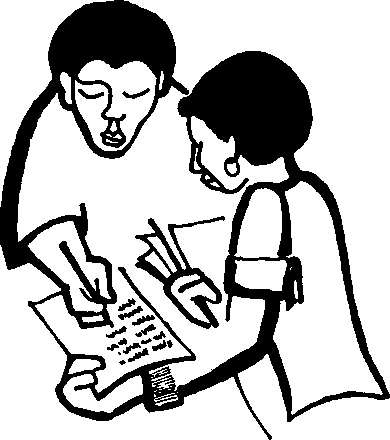Overview
Participants
plan, execute, and assess a letter-writing action about
a human rights issue of concern to them. Note: Participants
should be offered a range of topics and positions to ensure
that their letters are freely undertaken and reflect their
own views.
| Time: |
Variable |
| Materials: |
Stationery and envelopes,
stamps |
| Setting: |
Upper Elementary School - Adult
groups |
| Links: |
An appropriate follow up for
almost every activity in Part III. Excellent for ESL
and adult literacy programs. |
PART
A: Planning the Letter
1.
Define: Help participants identify the issue that
they wish to write about, which may develop from a particular
unit of this text, a service learning project, or an issue
of personal concern. Arrange participants with similar concerns
in small groups.
2.
Strategize: Working in small groups, strategize about
to whom to write:
- Is
this a local, state, national, or international issue?
- Is
this an issue that needs to be more widely known? Would
a letter to the editor of a newspaper be effective? What
community response is desired?
- Is
this an issue that needs attention from government agencies?
Which agencies are involved? What response is desired?
- Is
this an issue about which legislation is needed? Who are
the legislators involved? What response is involved?
3.
Research: Work cooperatively to gather the information
needed to write an effective letter.
- Verify
and expand your information.
- Identify
the best person(s) to whom to write and gather the needed
addresses.

PART
B: Writing the Letter
1.
Discuss the following tips on how to write an effective
letter. See Sample
Letter to the Editor for a product of these tips.
- Identify
yourself. If you are a student, mention your age or grade
in school. If you write as a class, mention your school’s
name.
- Define
the issue as specifically as possible.
- If
you ask for a response, make clear what you are asking
for.
- Keep
the letter as brief as possible to get your concerns across.
- Always
be polite.
- Stick
to information you have verified. Do not make claims you
cannot support with facts.
- Use
the correct forms for both the letter and the envelope.
Write carefully and neatly.
- If
possible, keep a copy of your letter.
2.
Go over the parts of a letter and envelope, pointing out
that a written letter is more effective.
3.
Ask participants to write drafts of their letters. When
they have finished, ask them to form groups of three. These
groups should take responsibility for editing each other’s
letters to make them polished enough to send to a head of
state or an editor.
4.
Ask participants to write final drafts of their letters
incorporating peer-editing comments and correctly address
an envelope. Encourage them to mail their letters.
PART
C: Writing for Special Situations
1.
Writing a Letter to the Editor: The following suggestions
will improve your chances of getting published:
- Look
for any rules printed in the publication to which you
plan to write. They are usually found at the end of the
"Letters to the Editor" section. Or telephone
or e-mail the publication to ask for special instructions.
- Follow
the suggestions for effective letter writing.
- Your
subject matter should be of current interest or relevance
to readers.
- Never
accuse anyone of anything without proof. Never slander
anyone. Remember that you want to solve problems, not
create them.
- If
you think something should be done, give a few reasons
why.
- Never
send a publication an "open letter" addressed
to a public official. It probably won’t be published.
- Don’t
send the same letter to more than one newspaper. Newspapers
like original work.
- If
your letter is printed, don’t be surprised or upset
if it has been shortened to fit the limited space available.
When the first 200 letters
came, the guards gave me back
my clothes. Then the next 200
letters came, and the prison
director came to see me. When
the next pile of letters arrived,
the director got in touch with
his superior. The letters kept
coming and coming: three thousand
of them. The President was informaed.
The letters still kept arriving,
and the President called the
prison and told them to let
me go.
-A
released prisoner of conscience from the Dominican Republic

